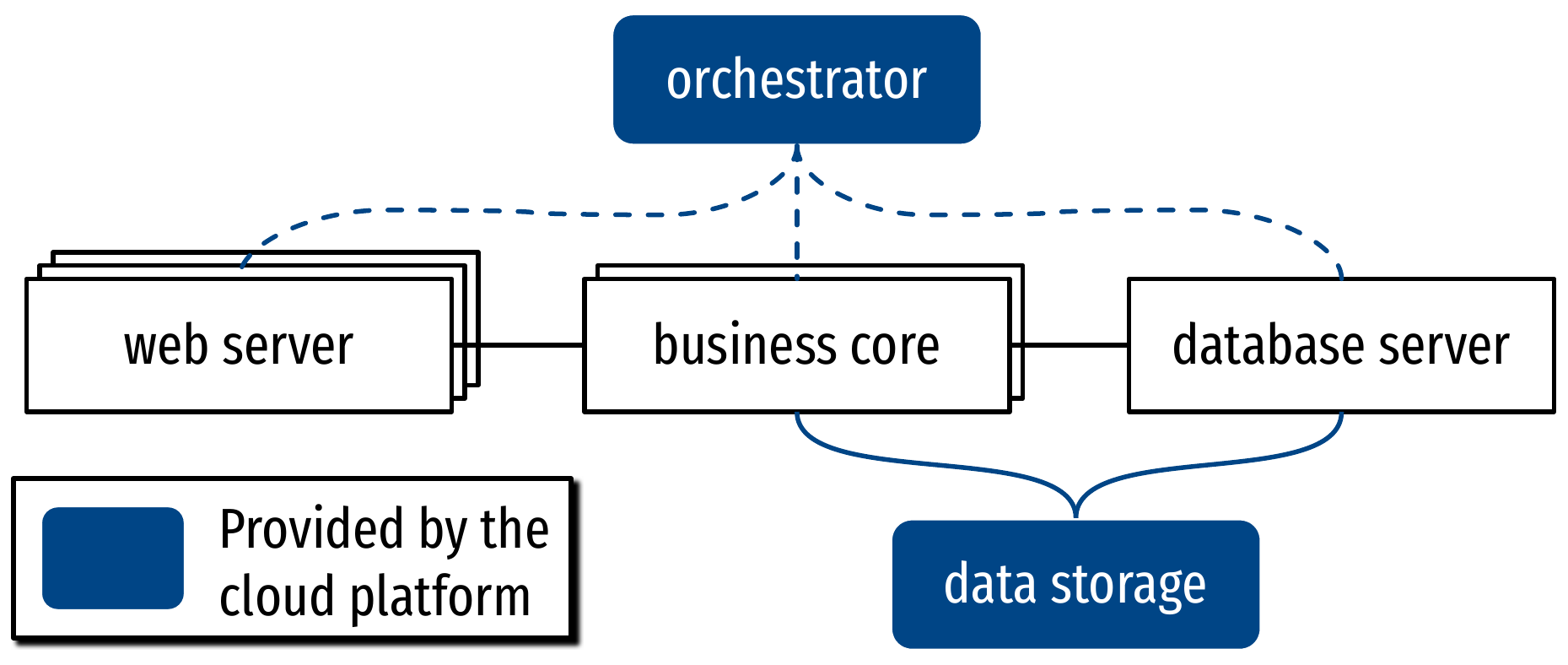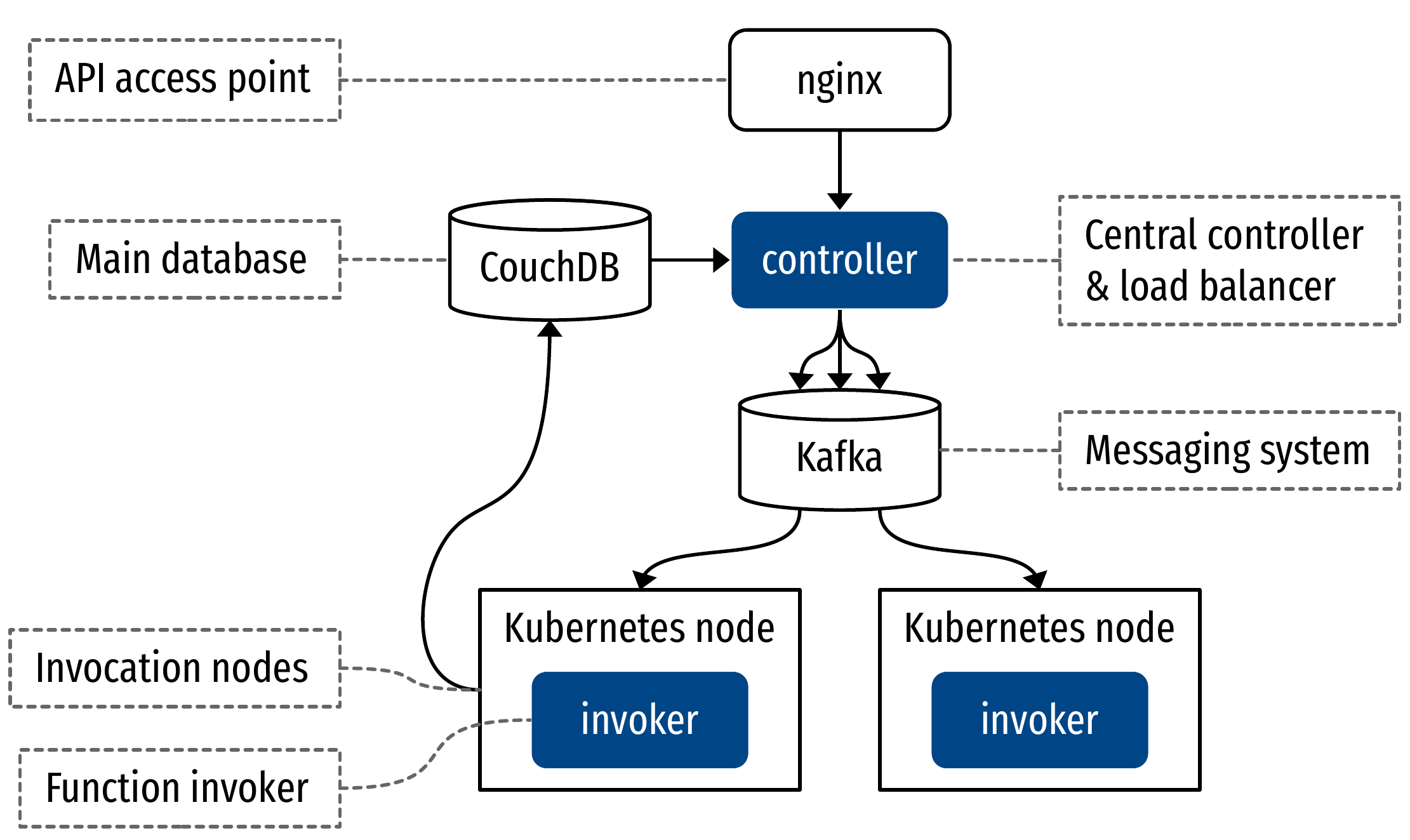Serverless Computing

Mathieu Bacou
mathieu.bacou@telecom-sudparis.eu
Télécom SudParis, IMT, IP Paris, Inria
2024–2025 CSC5004 — Cloud Computing Infrastructures
Do we really want Containers?
- An environment is required
- Overhead of building containers and pods
- A management layer is required
- Overhead of configuring service availability (orchestrator)
- Backends are required
- Overhead of management of support features
- Database servers, monitoring…
- Always-on servers
- May scale down to 0, but then latency overhead on next request
- Overhead of management of support features
Introducing: Serverless
- Real cloud-native applications: only provide code
to implement business core features
- A continuation from micro-services
- Management and execution service provided by the cloud platform
- From execution environment to service availability
- Serverless = Function-as-a-Service + Backend-as-a-Service
Backend-as-a-Service (BaaS)
- Common backend components in applications
architectures
- Database servers, messages queues, (object) storage, Pub/Sub services…
- A good thing: better served by the cloud provider
- Mutualized, no overhead for the user, always available
- Provides an ecosystem of ready-to-use components
- But beware of vendor lock-in!
- Elasticity requirements: scale in synchronization
with the FaaS workload (see next)
- dynamically
- quickly
- up and also down to zero
Function-as-a-Service (FaaS)
- Run application code without fixed long-lived servers
- Execution runtimes are spawned on-demand
- Fully managed by the cloud FaaS platform
- Unit of execution, and unit of application architecture: a
function
- I.e., a singular feature of the application
- Applications are (mostly) event-driven
- Triggered by requests or events from BaaS sources
- Parallelism at the level of the cloud function, managed by the
platform
- Technically, concurrency is possible inside the cloud function
- Core feature of serverless
Comparison with micro-services
- API gateway: managed routing of HTTP REST requests to functions
- Triggers: HTTP request, message queue, event stream, complex orchestration, timer, storage, etc.


Benefits of Function-as-a-Service
- Elasticity: granularity of the request handler
allows more precise scaling
- Quick scaling, each function can scale down to 0
- Deployment: just write code and upload it
- Quick experimentation, quick update
- Cost: pay only the compute time you need
- No request = no running function = no resource = no cost
- Cost = Compute time × Reserved Memory (approximately)
Demo: Apache OpenWhisk
- Create a new function
- Manually invoke a function
- Use the API gateway to invoker a function as the backend to REST requests
- Use triggers to integrate function invocation
- Present warm and cold starts

Application architecture with Function-as-a-Service (1/2)
- Most often following the paradigm of Extract – Transform –
Load (ETL)
- Get data
- Process data
- Output data
- Fit for event-driven processing
- Execute when a request arrives or a trigger is fired
- Stateless functions: no single instance is tied to
a request
- Consecutive invocations may be served by any instance (including new ones)
- FaaS uses BaaS to store business data
- FaaS relies on the API gateway or on the client to keep transient state

Application architecture with Function-as-a-Service (2/2)
- Most often following the paradigm of Extract – Transform –
Load (ETL)
- Get data
- Process data
- Output data
- Fit for event-driven processing
- Execute when a request arrives or a trigger is fired
- Stateless functions: no single instance is tied to
a request
- Consecutive invocations may be served by any instance (including new ones)
- FaaS uses BaaS to store business data
- FaaS relies on the API gateway or on the client to keep transient state

What makes a FaaS application
- Naturally multi-process thanks to platform-level parallelism
- Chains and graphs of processing
dependency between functions
- Chain function calls to implement complex features with fine control granularity
- Next level: handle a dependency graph (MapReduce pattern, etc.)
- Some vendors integrate it, often must be done manually
- In practice: platform-level configuration + code pieces
- To execute functions:
- Use provided environments: NodeJS, Python, Java…
- Or provide a custom environment: Docker images, opaque binary executables
Internals of Apache OpenWhisk

Invocation of a function
- Control authentication, rights to invoke, housekeeping…
- Spawn a new container with the function’s runtime
- Inject the function’s code
- Execute the function with the request’s parameters
- Retrieve the function’s result
- Destroy the container
- Optimizations for steps 2 and 6
Management of function runtime containers
- Creating a new runtime container is slow (compared to serving a
request)
- Hundreds of milliseconds vs. execution time of 100ms
- Solution: reuse existing containers!
- Functions are stateless: all containers with a function’s runtime are equivalent
- Cold starts and warm starts
- No runtime container available: cold start
- Available runtime (ready and idle): warm start
- Cold starts are around 40 times slower!
- Depends on function runtime, language…
- Importance of managing the runtime container pool
- Concerns:
- Maintain a pool of pre-warmed containers to speed up first requests
- But balance between occupied resources and execution latency
- Pre-warmed containers use resources that are not billed to the user!
Limits of serverless computing
- Latency:
- cold starts
- overhead of FaaS platform
- Compatibility with serverful applications
- What about stateful applications?
- No per-request local state
- What about massively parallel applications?
- Strong isolation between functions makes MPI hard
- FaaS is not fit for long-running processing
- Costs more, is less efficient
- What about stateful applications?
- Still a recent cloud paradigm!
- Promising for easy cloud access and cloud-native applications
Serverless computing
- Function-as-a-Service for core business code and features
- Backend-as-a-Service to provide architectural services
- Cloud-native paradigm
- Fine-grained, elastic, pay-as-you-go, no-management-overhead
- But not suited to all applications
- Yet?